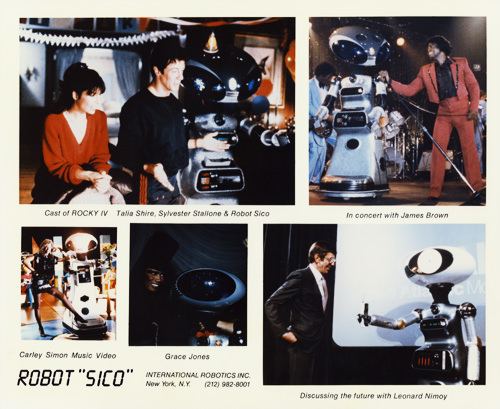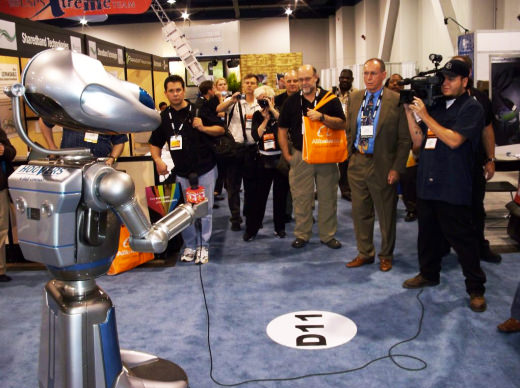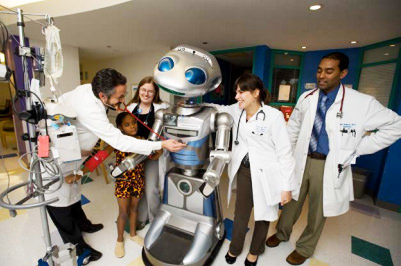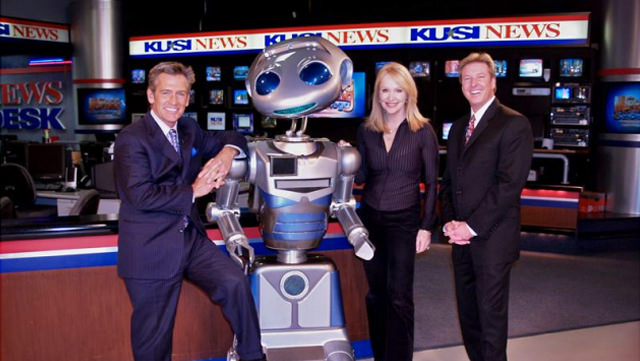The Rocky IV robot’s secret connection to autism treatment
The Rocky IV robot makes history
In a movie filled with sensational moments, it’s a surreal standout: Rocky IV’s sentient robot. Known to the world as the “Happy Birthday Paulie” robot, it’s a birthday gift to Paulie that entered the 80s-movie-robot canon. But why did a boxing movie include a robot?
A unique autism treatment made the connection.
How autism brought a robot to Rocky IV
“It was a very interesting story,” Robert Doornick says. He’s the founder of International Robotics, a firm that made the robot in Rocky IV (named Sico) and continues making similar robots today.
The story begins in the 1980s, when Doornick appeared on a talk show to promote his robot and discuss the work he’d done with autistic children. At that time, the disorder was even more enigmatic than it is today, and the idea of robotic treatment was literally years before its time. Still, Doornick believed, and still believes, that robots could communicate with autistic children more easily than people, in some circumstances. After the show aired, Doornick received an unexpected call.
“We got a call from the Stallone family…”“We got a call from the Stallone family,” he recalled in an interview with Trivia Happy. “They were very interested in how the robot could work with his son. One thing led to another and Stallone completely became enamored with Sico, that particular character.”
It wasn’t until 1985 when it became public knowledge that Stallone’s son, Seargeoh, was autistic. After an introduction, it was only a few steps for Doornick’s robot to become an icon in Rocky IV. Stallone offered to write Doornick’s robot into the film so he could work with his son. Doornick says the meeting between Sico and Seargeoh was “very successful” and that he and Stallone had a friendly rapport.
Without that talk show appearance and Doornick’s work with autistic children, Sico the robot may not have appeared in Rocky IV at all.
A robot captures Rocky’s heart
But make no mistake—the robot character became a quick favorite of Sylvester Stallone’s, and not just because he helped Seargeoh. Stallone loved the robot in the movie and even wrote in additional scenes. Stallone gave Doornick new lines and new scenes every couple of days, many of which were cut because they completely changed the tone of the movie.
Doornick recalls one particularly comic scene between the robot and Rocky’s brother-in-law, Paulie, that wound up on the cutting room floor. In the scene, Paulie and the robot had developed an odd couple relationship, with the robot complaining that Paulie always slept in the same t-shirt and made too much cigar smoke. The robot “found it offensive to [his] sensors.” So Paulie responded.
“Paulie shuts the robot down,” Doornick remembers, “opens the back panel, and changes the circuits to turn the robot completely female. Which is why in another scene, when the robot brings Paulie a beer, that’s my voice being synthesized into a woman’s voice. Most people in the movie don’t understand why the robot switched from a normal voice to a female voice. That’s why.”
A robot’s entertainment and business career, Rocky and beyond
The movie wasn’t the end of Sico’s involvement with Rocky IV—it was just the beginning. James Brown had a song in the movie, so Sico toured the country with the legendary singer. The robot appeared on all the major national stages, even doing 20 minutes of standup as an opening act. “The audience was wild,” Doornick says. “They’re saying, what the heck is this robot?” When James Brown sang the song from Rocky IV, Sico came back on stage to sing with him.

That and more helped make Sico the only robot with a SAG card (“It’s funny when you consider that this robot is a union member,” Doornick says with a laugh). The Rocky IV robot and his updated cousin, Millennia, have steadily appeared in big-ticket entertainment over the past 30 years, meeting everyone from Jay Leno to Jacques Cousteau.
Recently, the robot has appeared as an MC on Univision, traded jokes with Jimmy Fallon, was parodied on Family Guy, and even showed up on Punk’d. For the record, it’s not that easy to punk someone. Doornick said he felt horrible for punking Hilary Swank, though she was a “charming lady” who took the joke well (you can watch the episode where she falls for Sico’s prank).
His active entertainment portfolio is balanced with appearances at trade shows. The robot proves a strong draw when stationed at a booth. Controlled via remote control and a wrist microphone, Doornick lures in onlookers with robo-charm, like a modern Mechanical Turk. Using tried and true robot jokes, like “Are your batteries OK?” or “You have a nice container,” he then sends visitors to his “master” to learn about the product.

Doornick (and Sico’s) business and entertainment interests are enough to keep the company busy. But they complement a primary interest in helping children.
Using robots to help autistic children communicate
Doornick speaks with a trace of a French accent, and it gets the slightest bit stronger when he’s passionate. That happens when he speaks about using his robot to help autistic children. He believes it can make communication easier, though he’s clear he doesn’t believe it’s a miracle solution.
“We do not ever claim to be a cure for autism, we do not ever claim to be a solution,” he says. “What we have is an incredibly powerful tool that can at least connect.”
Doornick’s had autism treatment on his mind since the early 80s, but it’s borne out as a treatment method by some scientific literature and the work of his fellow roboticists. Doornick got his start in special education, and he’s since made it his mission to explore new ways to treat children and learn more about human/robot interaction. He believes his robots help autistic children by lowering their barriers to communication.

A typical visit to a hospital or school involves a group of children. The teacher will have singled out one or two for special attention. The robot enters the room and ignores the teacher in favor of the kids (so they think “that guy’s one of us”). Slowly, the robot progresses with the child it’s supposed to work with. Their human/robot conversation begins with mimicry and evolves to an actual dialogue.
In a recent visit, Doornick met a mother who said, “I just want you to know that you should not expect any results from my son.” By the end of the session, her son was standing on the robot’s sturdy platform, hugging the robot, and expressing affection. A similar visit ended with two boys standing on the robot’s platform and having a normal conversation.
The visits are free to the child and are funded by corporate sponsors, grants, or Doornick’s company. His work with children isn’t limited to those on the autism spectrum—obviously, any child would love to meet a robot. Millennia also shows up in sick wards and at schools. All children relate easily with the robot, and that makes it easier to forge connections, whether the children are on the autism spectrum or not.
The future for humans and robots

Doornick speaks easily—he’s funny and has the conversational ease of a salesman or experienced road comedian. He doesn’t need a robot to help him interface. But when asked if the robot helps him communicate, too, he answers yes almost immediately.
“The robot completely eliminates all the constraints of social protocols: stress, fears, anxieties, competitiveness, defense mechanisms.”“When I communicate through these robots, as is the case with all our other robots,” he says, “I have a tremendous ease connecting with human beings. They’re completely non-defensive. The robot completely eliminates all the constraints of social protocols: stress, fears, anxieties, competitiveness, defense mechanisms.”
In the same way talking through a robot makes him feel comfortable, he hopes human/robot psychology will continue to develop. “There is so much more yet to happen,” he says. “The robotics field is mushrooming right now but is still in its infancy. People are not focusing too much on the psychology of robotics, which is what our company really pioneered.”
Doornick’s most interested in the human possibilities of robots, not the geeky technical opportunities (though he admires iRobot, he doesn’t even own a Roomba). His human interest is reflected in the pleasure he gets from the diverse parts of his business: entertainment, sales and trade shows, and work with children. All of them focus on humans and robots coming together, and it’s paid off.
After all, not many people can claim to have been the controls behind a robot that made out with Carly Simon.




